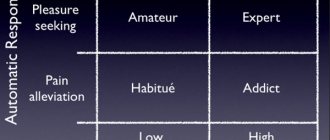Adolescence is of particular interest for study, since it is during this period that the child ceases to be a child, but is not yet an adult; he is just beginning to develop his behavioral skills in society, which is why delinquent behavior is often manifested. The state tolerates some capriciousness of teenagers who try to prove their adulthood in various forms. However, there is a limit to everything. Some offenses committed by teenagers are punishable, as parents are well aware of.
The online magazine psytheater.com calls delinquent behavior actions directed against established rules, laws and orders in society. Some of them are illegal, such as alcoholism, prostitution or theft. Teenagers are guided by their own principles, so they can commit an act that will lead to punishment. And if punishment does not happen, then the teenager often allows himself to commit it again.
Numerous problems associated with adolescence (drugs, shocking appearance, bad friends, rudeness, etc.) are the instinctive need of the younger generation to “break the umbilical cord connecting child and mother” and find an “adult element” to strive for. In other words, the teenager instinctively tries to stop being a child and begin his journey towards becoming an adult. But due to the fact that he does not have examples of truly adult people to look up to, he only resorts to elements that he thinks will make him an adult - sex, drinking, fighting, etc. And the problem is The only thing is that he does not have a real example of an adult whom he would strive to be like.
Adolescence is the stage when a person begins to mature. There is no guarantee that he will actually become an adult as a boy or girl. For many people, this stage drags on for many years, reaching old age. This is why you can find grown men and women over 50 acting like teenagers. Outwardly they aged, but inside they never grew up, stuck at the stage when they were teenagers.
At the same time, a social problem is the fact that the new generation is trying to find role models among adults and does not find them. Since many adults have not yet become mature and responsible themselves and act like teenagers, what can we say about those who are trying to imitate them. Various teenage behaviors that are unacceptable to parents are simply a reflection of the fact that children do not have role models to show them what it means to be adults. They copy adults who have not yet grown up themselves and behave like children. It becomes a vicious circle when parents expect teenagers to act like adults, but at the same time they themselves behave like teenagers, whom their children copy.
Many people simply don't want to grow up because then they become responsible for everything they do, think and say. People are not used to this: it is easier for them to do something, and in case of failure, shift the blame to another person or circumstances. An adult is required to be constantly responsible for everything that happens to him.
Between the position of a “child” and the position of an “adult” lies a certain stressful situation. A person, getting into it, is “zeroed” and, depending on the paths he takes to leave it, he will return to his previous state of a “child” (i.e., he will be guided by old patterns of behavior) or become an “adult” (i.e. e. will develop a completely different personality with new patterns of behavior).
To grow up, a person must go through a deeply stressful situation where no one can help him except himself. Then, solving all the problems that have arisen on his own, he will use his old behavioral models that he used in childhood (for example, being offended and blaming the world for injustice), or will form new models that he has never used before, realizing that he is carrying responsibility for every decision, action and word (for example, he will stop blaming the world for injustice and try to solve the problem).
You need to “reset”, that is, get into a problematic situation where no one can help you. Then you will have to independently choose how to proceed in this situation, and bear full responsibility for it.
What is delinquent behavior?
Teenagers are mostly distinguished by their loud and explosive behavior, which is based mainly on emotions. However, not every behavior is acceptable in society. And here a term such as delinquent behavior arises, which implies the destructive actions of a teenager who directs them against the rules and norms of society. They are directed against the laws of the state, and therefore can sometimes be of a criminal or illegal nature.
Criminal behavior is one of the forms of delinquent behavior. Not every behavior that deviates from the norm is delinquent, but all delinquent behavior is deviant. Delinquent behavior is directed against the rules and laws of the state. If a teenager commits offenses that violate the law, then upon reaching adulthood he becomes an antisocial person. If a teenager’s actions simply violate the norms of morality and behavior, then he is classified as an antisocial person.
Many older people have a negative attitude towards the behavior of teenagers, calling it criminal. However, this is an exaggerated opinion. Teenagers may listen to loud music or go out at night, which is not illegal behavior. However, if teenagers begin to swear, get involved in alcohol, drugs, promiscuity, or commit criminal acts, then their behavior should be punished.
Delinquent behavior has a number of features:
- It is difficult to separate illegal behavior from destructive behavior.
- Illegal behavior is the most serious and problematic for society.
- Delinquent behavior is clearly regulated by laws and regulations.
- Conflict always arises between a teenager and the whole society, its order.
Why is the government so concerned about what teenagers do? Delinquent behavior not only contradicts the laws and rules of society, but also triggers a mechanism of permissiveness and lack of order within the country. The state must ensure that every citizen observes certain rules of decency, otherwise such a state becomes weak and insolvent.
go to top
“One Life”: a training program for the prevention of deviant behavior in adolescents
The preventive training program is intended for group classes with adolescents aged 14 to 18 years. The content of the exercises is aimed at preventing neglect and homelessness among teenagers, helping minors in difficult life situations to adapt, who have a conflict with the law and are registered with police departments, as well as for teenagers whose behavior is characterized as addictive.
Main objectives of the training:
1. Formation of responsibility in a teenager for his actions.
2. Increasing self-esteem, developing skills to manage your feelings and emotions.
3. Development in participants of effective behavioral skills to counter the negative influence of the environment in risky situations, socially acceptable forms of behavior.[1]
4. Prevention of neglect and homelessness, social maladjustment and delinquency among adolescents.
Main goals:
1. Form positive motivation and attitudes aimed at resisting the unwanted influence of the environment.
2. Help participants evaluate and adjust their attitudes regarding illegal behavior in general and their own in particular.
3. Increase the level of knowledge of training participants about their rights, responsibilities, causes and consequences of offenses.
4. Develop in participants effective skills of self-control and assessment of their own emotional state in order to make the right decisions.
5. Involve teenagers in positive activities that are adequate to their interests, abilities and mental state, which can distract them from committing crimes.
Expected results:
1. Mastering an adequate understanding of the consequences of committing offenses, one’s rights and responsibilities.
2. Updating in adolescents a sense of confidence in their abilities, resisting unwanted environmental influences and the skill of defending safe behavior in various situations.
3. Developed ability to communicate effectively with other people, especially in high-risk situations.
4. Teenagers’ understanding of the destructive effects of drugs and alcohol.[1]
A set of exercises and methodological recommendations for their implementation
Exercise No. 1 “What will I gain / what will I lose”
Having committed an offense, a person knows the consequences, but takes risks, seeing some kind of advantage for himself. The facilitator invites the participants to divide into groups. If there are a small number of participants, it is possible to conduct the exercise in the form of a “brainstorming”, without dividing into groups.
Each group will have to answer two questions: “What will I gain from committing an offense?”, “What will I lose from committing an offense?” Answer options are written down on separate sheets of paper. For consideration, a specific situation of unlawful behavior is given at the discretion of the presenter, for example, “theft of a mobile phone,” “hooliganism in public transport,” “beating up a classmate,” etc.
You are given 5-7 minutes to complete the exercise. The results of the groups’ work are then discussed within the framework of the question “If an offense is committed, what consequences does this entail for the person who committed the offense?” All possible answers are heard. Create your own group definitions of consequences.[1]
Exercise No. 2 “Letter to Indignation”
The presenter gives the instruction: “Try to write a letter to your indignation, try to tell him how you have to get along with him; how do you live with him and how do you live without him. Try to evaluate how resentment benefits and harms you, and also try to evaluate how resentment can affect your relationships with other people.”
Independent work of participants to complete the leader’s installation. At the end of the exercise, you can, with the consent of the participants, read “letters to indignation.”
Exercise No. 3 “Learning to resist influence”
Influence is the ability to persuade someone to do what you want, or the ability to take action that changes the outcome of a situation. In this exercise, teenagers are asked to discuss a series of questions:
What is influence, what or who can be influenced?
Is the influence always negative?
How can you identify negative influences?
What are the ways of negative influence (intimidation, blackmail, threat, imitation, addiction, beating, pressure on the individual, etc.)?
Would the participants personally be willing to succumb to such influence and what consequences might the agreement lead to?
What needs to be done to get away from negative influence?
Next, a safety plan is drawn up and the leader needs to convince teenagers that asking for help is not an admission of one’s own weakness, but a manifestation of the ability to resist. The plan includes points not only of self-help and mutual assistance, but also an appeal to parents, relatives, and adults; to specialist teachers; to the police, hotlines, schools, social services.[2]
Exercise No. 4 Group discussion “Responsibility for actions”
In the discussion, the presenter suggests recalling situations that you might have seen on television, when a hero broke the law, perhaps even by a group of people. Next, a group discussion of this situation is organized on the questions: What was violated in this case? Why? What was the outcome? At the same time, the task is to try to create a dialogue among the training participants and evaluate the action not only from the side of criminal punishment, but also from public condemnation.
Exercise No. 5 “Piano”
Presenter's opening remarks: «
Think and remember what you do when you feel bad? How do you try to cope with a bad condition? Please share your experience of behavior in these situations.”
Participants voice ways to overcome their “bad state”, and the presenter writes them down, each method on a separate sheet of paper and then lays them out on the floor like keys on a piano. After this, he makes a generalization: “So, in our group these methods work...” (lists, especially emphasizing such answers as alcohol, drugs, sweets, computer, aggression and other deviations.
The facilitator brings the training group to the question: “Each person has his own ways of coping with poor health, some have a lot of them, some have few. What do you think is better – to have many or few “keys”? Then he concludes: “Of course, it’s better when there are a lot of “keys.” This means that a person knows many ways to cope with a bad mood. For example, in one situation you can cry, in another you need to think carefully, in a third you need to ask for help, etc. What if a person only has one “key”? Participants must be brought to the conclusion during the discussion: “If there is one “key”, then in every situation he will act the same way, he simply cannot do it any other way.”
Moving on to a discussion of addictions: “What if this “key” is drugs? Yes, then addiction arises. Dependence can appear not only from drugs, but, for example, from a computer, alcohol, food, and gambling. There are now more than 200 types of different addictions. Dependence occurs when a person “other “keys” on the piano do not work.” What about the number of “keys”? What are your thoughts and feelings about this? Your comments?".[2]
Exercise No. 6 “Fairy Tale”
The leading coach invites the children to divide into two groups and compose a fairy tale about the Far Far Away State, in which a king and queen, as well as their people, would live. Each group is assigned a specific task. The first group writes a fairy tale about where the laws exist and how they are observed. The second group composes a fairy tale where there are no laws and where they are not observed at all - about a state of lawlessness. 10-15 minutes are allotted for work. Each group presents their own fairy tale. Discussion follows. The guys are asked to answer the questions:
In which country did the people live better? Why?
Is it necessary to monitor the implementation of laws? For what?
Are laws needed at all? What is their role?
Exercise No. 7 “I like about you...”
The facilitator organizes the interaction of the participants: “We stand in a circle, and one of us - the person who wants to - stands in the middle of the circle. Each of us who stands in the circle will say something good about the character qualities and actions of the one who stands in the center, starting with the words “I like about you...”. We need to give everyone the opportunity to participate.
After playing, it is important to discuss how the participants felt standing in the center of the circle.
In conclusion, the presenter needs to say that other people need to be accepted for who they are. You should not be biased towards those people who are different from you, because we are all individual.
This preventive training program was developed and tested for social service specialists and can be implemented by them in their professional activities when working with minors to prevent addictive behavior, delinquency, and neglect of adolescents, in order to motivate the younger generation to lead a healthy lifestyle. The advantage of this program, compared to other methods of social education, is that it is aimed not only at solving existing problems of minors, their social rehabilitation, but also at the primary prevention of deviant behavior.
Delinquent and deviant behavior
In psychology, two terms of behavior are used - delinquent and deviant. Despite their similarities, they have their differences:
- Deviant behavior is mainly directed against the rules and morals established in society. Delinquent behavior is opposed to law and order in the state.
- Deviant behavior is regulated exclusively by the teenager’s relationships with people around him. Delinquent behavior is regulated by law; if you go against it, then there will be punishment.
- Deviant behavior can be directed against specific individuals or an entire group. Delinquent behavior is directed against the rules of society as a whole.
Deviant behavior is condemned by criticism and condemnation, and delinquent behavior may be criminally punishable. Acts of a delinquent nature are called torts, and the criminal is called a delinquent. Usually the state punishes criminals according to all the rules, but usually the criminal himself becomes even more embittered against the social order, which is why he continues to commit actions that please him. That is why punishment in this case does not have the desired effect. Prevention of delinquent behavior becomes useful.
go to top
Correction of delinquent behavior of the criminal personality
The problem of correction, in particular psychocorrection of the attitude of the criminal’s personality to the crime, seems complex [1, 2, 3, 4, 5]. Here, psychocorrection means a targeted impact on the individual in order to optimize the mental state, promoting liberation from internal experiences, the inclusion of volitional mechanisms, intensifying the search for adequate ways to respond to problem situations, along with an understanding of one’s relationships with others, which promotes positive changes in behavior [25, 26 , 27, 28, 29, 30, 31, 32].
Deviant behavior is a complex social and psychological phenomenon. This is persistent behavior of an individual, deviating from the most important social norms, causing real damage to society or the individual himself, and also accompanied by social maladjustment. Deviant behavior occupies a middle position between norm and pathology – the so-called borderline position. The behavior of juvenile offenders is characterized by cruelty, aggressiveness, risk-taking, and irresponsibility. Deceitfulness, theft, running away from home, hooliganism, vandalism, vagrancy, begging, early onset of sexual activity, and prostitution may occur [6, 7, 8, 9, 10, 11]. Such behavior, in its extreme forms representing a criminal act, is called delinquent, and the offender is called a delinquent.
The problem of psychocorrectional work with “difficult” convicts, in particular with juvenile delinquents, with their often inherent character accentuations, borderline mental disorders, increased aggressiveness, psychoses, neuroses, mental retardations, pathocharacterological personality changes, taking into account the specifics of penitentiary practice, which consists in the need corrections are especially difficult.
The penitentiary system refers to the penal system as a whole. The modern penitentiary system not only carries out the punishment imposed by the court, but it should contribute to the moral correction of convicts, repentance, and renunciation of a criminal lifestyle in the future [12, 20, 21, 22, 23, 24].
The reform of the penal system carried out on the initiative of the President of Russia, which includes the organizational replacement of correctional colonies with prisons and settlement colonies, will ensure that criminal authorities are kept in isolation from other convicts [1, 13, 14, 15]. It is possible that, returning to the strict isolation in cell conditions within the prison regime that took place in the 50s of the twentieth century, the penitentiary system will create conditions for their active repentance of their deeds. Psychological work among convicts is also being optimized. In providing effective social and psychological assistance to convicts during the reform of the penal system, the emphasis is on strengthening psychological and pedagogical work with convicts and preparing them for life in freedom, resocialization [1, 16, 17, 18, 19, 20]. It is assumed that the transformation of educational colonies into educational centers will allow for better work on the resocialization of delinquent adolescents and young men in order to return them to society as law-abiding citizens.
After establishing the guilt of the defendant, the court, when determining the punishment, takes into account factors such as personality characteristics, circumstances aggravating or mitigating the responsibility of the offender. The narrative part of the verdict must indicate whether the defendant admitted his guilt. A unique guarantee of sincere awareness of the harm caused is repentance. It involves an admission of guilt in a crime. You can only repent if you are truly guilty. At the same time, one can admit guilt, but not repent and consciously refuse to repent. Admitting guilt does not always mean realizing it.
The practical experience of the psychological service of the penitentiary system of the Voronezh region shows that true repentance of convicts is facilitated by psychocorrectional work carried out within the framework of the classical triad scheme of the Gestalt approach: relevance - awareness - responsibility (German: Aktualität - Bewusstheit - Verantwortlichkeit). At the same time, the sincerity of repentance for criminal activity can be assessed only after a person with criminal experience lives a law-abiding, full life.
Gestalt therapy is based on four principles: the principle of integrity (Gestalt), the principle of expanding consciousness, the principle of focusing on the present (“here and now”), the principle of working with opposites. The Gestalt approach, “gestalt” translated from German as “image”, “integrity” (ganzheit), promotes an individual’s awareness of the mechanisms that push them to repeat habitual patterns of behavior, acquiring an internal locus of control and developing the ability to take responsibility for their thoughts, experiences, words, actions, lifestyle [4].
The effectiveness of psychologists’ activities in this direction is confirmed by the experience of using the author’s Gestalt-oriented psychocorrectional art program “Jumping the Chasm” - a method of psychological rehabilitation of the personality of a drug-addicted teenager [2]. This psychocorrectional program, codenamed “Draw yourself free,” was tested on the basis of the Bobrovskaya VK (penal system of the Voronezh region) in the process of providing psychological assistance to the inmates of the colony in getting rid of addiction to psychoactive substances.
The effectiveness of the Jump the Chasm art program includes:
- awareness of the reasons for committing a crime, the formation of a sense of repentance in a delinquent person;
- stabilization of the state of remission - reduction of drug addiction;
- reduction in the number of violations of the regime of detention in the VK, the emergence of a desire to comply with social attitudes and roles;
- improvement of memory, ability to concentrate;
- increased social activity, desire for law-abiding behavior;
- formation of positive life plans;
- the emergence of a desire for parole from serving a criminal sentence;
- effectiveness according to subjective (psychological) indicators.
The mechanism for correcting negative mental states of an individual, the process of positive changes that change criminal attitudes and promote awareness of the true reasons for committing a crime, the formation of a sense of repentance, and responsibility for one’s behavior is as follows: the individual begins to think about the consequences of one’s own and others’ actions, which entails awareness of one’s own guilt in committing a crime followed by repentance.
Awareness promotes repentance and the formation of a sense of responsibility: gradually understanding oneself, a person comprehends the effects of one’s own personality on others, developing the ability to comprehend possible deviations in one’s behavior. True repentance is always proportionate to the gravity of the crime committed. Repentance reflects the process of developing a sense of guilt and responsibility of the convicted person for the crime committed, his actions, and the desire to renounce criminal behavior in the future life.
The result of psychocorrectional influence is the harmonization of personality: the emerging psychoenergetic reserves are directed by a person for fundamental changes in his life at the social, psychological and psychophysiological level.
Delinquent behavior of adolescents
It is in adolescence that a person begins to become an adult, trying himself and finding his place “under the sun.” Delinquent behavior is often formed in a group of friends, where there is a leader or even an older person than the other participants. They have no interests, do not engage in studies, sports and other useful activities. Out of boredom, they begin to drink alcohol, drugs, and commit various harmful acts. Here we can distinguish three groups of such teenagers:
- The first group includes teenagers who have moral principles, but there is conflict within them. They often become suggestible and impulsive in their actions, after which they repent and reform.
- The second group includes teenagers with internal conflict, but they no longer have remorse or guilt. They do things because it is convenient for them.
- The third group includes teenagers without any internal conflict. They commit illegal acts consciously, taking pleasure in it and fully aware of how harmful their actions are.
Delinquent behavior does not just happen. It is preceded by certain reasons, which are seen in the following:
- The economic situation in the country, when teenagers absorb the idea that they should be rich and successful, but their actual financial capabilities are very small and limited.
- Family environment. If a teenager does not have a relationship with his parents, who overprotect him, ignore him, order him, do not respect him, do not love him, do not listen, then illegal behavior arises.
- A decrease in the importance of moral and cultural values in society, which is absorbed by teenagers.
- An unstable situation in the country, which may undergo various changes that affect the perception of the world by adolescents.
- Infatuation with watching various action and horror films, in which there is no censorship, everyone kills each other and causes physical harm.
- The presence of internal conflicts when a teenager does not correspond to his ideal “I”.
Since a teenager is not able to control his emotions, and also often blames others for his troubles, he prefers to commit delinquent acts. Having caused some harm to society, he does not see anything wrong with it, since he believes that he committed a just action in revenge for his grief.
Teenagers really need respect, love and attention to themselves. Moreover, they do not need moralizing, but rather a respectful, equal position. If a child does not experience the required feelings for himself in the family and at school, then he becomes prone to destructive behavior.
Another reason for delinquent behavior is the need to receive pleasant emotions. If a child is not friends with anyone, is not successful in school, and is not loved by his parents, then he may experience pleasant experiences after drinking alcohol or having sex. If these methods of achieving happiness are the strongest and brightest, then the teenager will begin to resort to them.
Lack of hobbies and having a lot of free time that has nowhere to go can also cause delinquent behavior. The teenager will simply look for himself in at least something that can lead him to illegal behavior.
go to top
Prevention of delinquent behavior in adolescents consultation on the topic
Measures to prevent delinquent behavior in adolescents
Changes in the socio-economic sphere in Russia have entailed changes in the state of the entire modern society. In the current situation, vulnerable groups of the population, which include minors, need special protection. The problem of deviant and delinquent behavior of minors is one of the most pressing today.
Delinquent behavior is the actions of a specific individual that deviate from the laws established in a given society and at a given time, that threaten the well-being of other people or social order and are criminally punishable in their extreme manifestations (E.V. Zmanovsky).
Delinquent behavior is one of the forms of deviant behavior that cannot be a positive phenomenon, it is always condemned and punished, such behavior is regulated by special social institutions: courts, investigative bodies, places of deprivation of liberty.
The beginning of delinquent behavior is absenteeism from school, joining an associational group of peers. What follows is petty hooliganism, mockery of the weaker. But such actions of teenagers cannot serve as a reason for punishment in accordance with the Criminal Code of the Russian Federation.
There are many reasons for delinquent behavior. The most important of them:
- Macrosocial: imperfect legislation; various social processes (crisis); crime detection rate, etc.
- Microsocial: family dysfunction; negative social environment; poor relationships with peers; bad habits, etc.
- Psychological: the presence of hereditary diseases, psychopathologies; personality traits and temperament, etc.
To solve the problem of delinquent behavior of a teenager, it is necessary to understand what factors influenced the appearance of his unlawful act, and then you can try to eliminate or mitigate these factors.
It is easier to help a child when delinquent behavior has just begun to appear than when he has already been leading an associative lifestyle for a large amount of time.
Social institutions play a huge role in preventing and mitigating the manifestation of forms of delinquent behavior: family, school, state.
At school, the system of work to prevent the manifestation of delinquent behavior in adolescents includes preventive measures. The socio-pedagogical technology used in preventive work is a set of measures - organizational, cultural, educational and others.
Preventive activities are aimed at:
- Forming a teenager’s motivation for socio-psychological and physical development (the desire to lead a healthy lifestyle).
- Forming a person’s motivation to provide support to their loved ones. After all, people more easily overcome obstacles and solve their problems if they have a developed social support network (family, friends).
- Forming the motivation of children at risk and their families to change their behavior and lifestyle.
Public organizations and movements play an important role in working with deviant teenagers. In school, the following can successfully work with this group of teenagers:
— School reconciliation service.
SHSP activists work with teenagers and help resolve conflicts in a constructive and peaceful way. The main method of work is the use of mediation. Conciliation services are a tool that helps solve the problem of responding to the unlawful behavior of a minor. The mediator’s work is aimed at instilling responsibility in the offender not through punishment, but as an obligation to make amends for the harm caused.
— Volunteer movement.
The volunteer movement at school is one of the forms of involving teenagers in social activity and is designed to contribute to the formation and improvement of the political and social competence of the younger generation.
Commandments of school volunteers:
- Find someone who needs your support, help, protect him.
- Reveal yourself in any activity that is useful for others and yourself.
- Remember that your strength and your value are in your health.
- Evaluate yourself and your comrades not by words, but by real relationships and actions.
- Lead a healthy lifestyle! Your lifestyle is an example to follow.
— “Social living room.”
“The Social Living Room” is designed to provide comprehensive socio-psychological and pedagogical support and assistance to students who find themselves in difficult life circumstances, to recreate lost emotional connections and the positive attitude of parents from socially maladjusted families towards their children.
Main activities:
– organization of individual work with children (phased implementation of individual programs for social rehabilitation of minors, psychological and pedagogical correction and socio-legal support in difficult life situations);
– assistance in preparing homework, conducting additional classes in subjects, organizing educational activities;
– restoration of broken connections with school; development of communication skills with adults and peers based on norms and rules of behavior;
– prevention of behavioral deviations;
– restoration of lost interpersonal relationships within the family;
– involving children in a variety of activities (system of additional education);
– assisting parents in raising children and overcoming family conflicts;
– providing emergency psychological assistance to families;
– consulting parents on issues of psychology and pedagogy;
– organization of family children's parties, competitions, theme evenings.
The problem of deviant and delinquent behavior of adolescents should be in the attention of the entire public. To further develop our society and improve the quality of life of the population, it is necessary to continue to develop areas of work to prevent and combat deviant and delinquent behavior of adolescents, to continue to improve legislation regarding adolescents and to create conditions for organizing comprehensive prevention of juvenile delinquency.
Forms of delinquent behavior
Common forms of delinquent behavior are:
- Crime. Children from dysfunctional families and in the presence of a deteriorating personality often take such actions.
- Addiction. The desire for pleasure that cannot be obtained in ordinary life allows one to become addicted to drugs or alcohol.
- Prostitution. Here, the reasons for its occurrence are two factors: a way of earning money, when a teenager simply does not have money for what he wants, and a way of receiving attention and love, which parents do not give.
Since adolescents who have lost contact with adults often develop delinquent behavior, they simply do not know in what ways they can solve their problems so as not to resort to prostitution, alcohol, drug addiction or crime. A child who simply does not know how to solve his problem in a peaceful way becomes a delinquent.
go to top
What kind of prevention of delinquent behavior can be carried out as a result?
It is better to prevent delinquent behavior than to eliminate it. And this is where prevention can help:
- A prosperous relationship between parents and a child, when he is respected, heard, appreciated, supported, and helped. Here it is important for parents to notice children's problems and help in finding peaceful ways to solve them.
- Elimination of films and programs showing violence.
- Promoting school performance. It is not necessary to be an excellent student, but the child must receive good grades in at least some subjects.
- Emotionally positive attitude. The child should receive positive emotions from everyday life.
- Having friends, when the child will be surrounded by people with moral principles and values.










